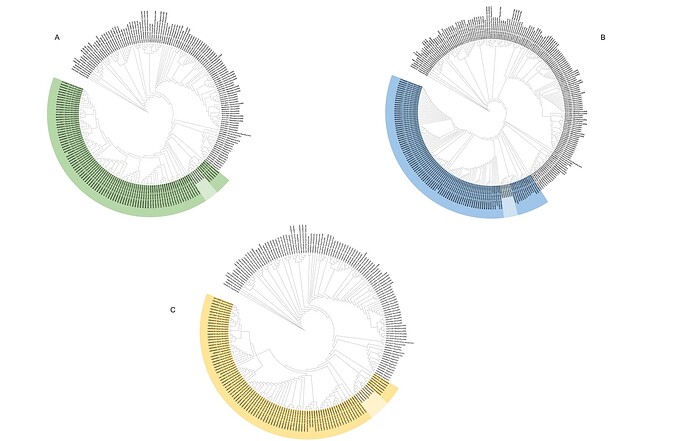Molecular characterization of Rift Valley fever virus from the 2025 outbreak in northern Senegal.
Authors: Moussa Moïse Diagne¹*, Gamou Fall¹*, Abiboulaye Sall², Bocar Sow³,⁴, Ndeye Awa Ndiaye¹, Alioune Gaye⁵, Mamadou Sarr Ndao³, Aboubacry Gaye⁶, El Hadji Ndiaye⁵, Seynabou Mbaye Ba Souna Diop¹, Safietou Sankhe¹, Mouhamed Kane¹, Seynabou Ndiaye², Ousmane Faye³, Yoro Sall², Mamadou Aliou Barry⁶, Ibou Gueye², Marie Henriette Dior Ndione¹, Boly Diop², Ousmane Cissé², Joseph R A Fitchett⁷, Ibrahima Dia⁵, Cheikh Loucoubar⁶, Ndongo Dia¹, Mawlouth Diallo⁵, Boubacar Diallo³, Ibrahima Socé Fall⁸, Mamadou Ndiaye², Diawo Diallo⁵*, Abdourahmane Sow³,⁴*, Oumar Faye¹*
¹ Virology Department, Institut Pasteur de Dakar, Senegal
² Ministry of Health and Public Hygiene, Senegal
³ Public Health Direction, Institut Pasteur de Dakar, Senegal
⁴ Department of Public Health and Preventive Medicine, UCAD, Senegal
⁵ Zoology Medical Department, Institut Pasteur de Dakar, Senegal
⁶ Epidemiology, Clinical Research and Data Science Department, Institut Pasteur de Dakar, Senegal
⁷ Biotechnology Advisory Office, Institut Pasteur de Dakar, Senegal
⁸ Chief Executive Office, Institut Pasteur de Dakar, Senegal
*Equal contribution +Corresponding author: [email protected]
Summary
In September 2025, a severe Rift Valley fever (RVF) outbreak affected northern Senegal (Saint-Louis, Matam, and Louga regions), causing >600 suspected cases, 119 laboratory-confirmed infections and 15 deaths.
The Institut Pasteur de Dakar sequenced nine RT-qPCR–positive samples using the Twist CVRP hybrid-capture workflow on an Illumina iSeq100. Five complete L/M/S genomes were recovered.
Phylogenetic analyses show all 2025 Senegal sequences belong to lineage H, clustering with earlier Senegalese isolates from Fatick (2020) and Matam (2022) (>99 % nt identity). This confirms continued local persistence rather than new introduction.
Genomic features
| Segment | Genome coverage | Key findings |
|---|---|---|
| L, M, S | > 99 % for five samples | High conservation; lineage H marker mutations present |
| Non-conservative (L polymerase) | D11N, M120T, Y1852H | Located in endonuclease and C-terminal regions; may fine-tune replication |
| Conservative | R137K (NSs), K1111R (NSm) | Neutral; interferon antagonism and epitopes preserved |
| Selection pressure | Mostly purifying (Z > 0) | Indicates functional constraint and stability |
No amino-acid changes were found in Gn/Gc neutralizing epitopes, implying current vaccine targets remain valid.
Three non-conservative L mutations (D11N, M120T, Y1852H) may affect replication kinetics via endonuclase and C-terminal fine tuning.
This lineage was also linked to high fatality outbreaks in Mauritania (2020) and now Senegal (2025).
Interpretation
-
2025 Senegal cluster = ongoing lineage H circulation, not a new introduction.
-
High conservation + moderate adaptive signals → locally adapted strain.
-
Minor L polymerase changes → possible fine-tuning of replication efficiency.
-
Clinical severity matches previous lineage H patterns (Mauritania 2020).
Next steps
Ongoing One Health investigations (Saint-Louis & Matam) assess mosquito infection rates, livestock amplification and human exposure to clarify drivers of this high-lethality event.
Updated genomes will be released to GISAID and GenBank after curation.
Data availability
Consensus genomes (2025 Senegal) submitted to GenBank [accessions pending].Raw FASTQ files and analysis scripts available on request to Institut Pasteur de Dakar.
Acknowledgments
We thank the Senegalese Ministry of Health teams for outbreak response and sample collection, and the departments of the Institut Pasteur de Dakar for technical support.
Supported by the Bill & Melinda Gates Foundation through the Africa Pathogen Genomics Initiative, by UK FCDO and by US CDC Cooperation Agreement.
Contact
-Dr Moussa Moïse Diagne – [email protected]; Virology Department, Institut Pasteur de Dakar
-Dr Gamou Fall – [email protected]; Virology Department, Institut Pasteur de Dakar
-Dr Oumar Faye – [email protected]; Virology Department, Institut Pasteur de Dakar
-Dr Abdourahmane Sow – [email protected]; Public Health Direction, Institut Pasteur de Dakar
-Dr Ibrahima Soce Fall – [email protected]; Chief Executive Office, Institut Pasteur de Dakar
RVF 2025_Figure 1.pdf (7.2 MB)
Figure 1. Maximum-likelihood phylogenetic trees of the L (A), S (B) and M (C) segments constructed from complete and nearly complete Rift Valley fever virus genomes available in GenBank. Sequences belonging to lineage H (highlighted) include the 2025 Senegal outbreak genomes, which cluster with earlier isolates from Fatick (2020), Matam (2022) and Mauritania (2020), indicating ongoing local circulation rather than a new introduction.
